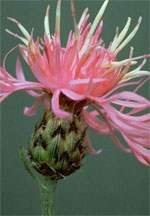Threats to Birds - Spotted Knapweed (Centaurea maculosa)
Overview
This perennial weed was first reported in Montana in 1920, and had increased to over 4 million acres in that state alone by 1995. Early introductions were through contaminated alfalfa and discarded soil used as ship ballast. Spotted knapweed infests rangeland throughout the western U.S. and Canada, including every county in Montana, Washington, Idaho, and Wyoming. Spotted knapweed displaces native rangeland perennial grasses such as blue bunchweed grass and Idaho fescue. It hurts the soil by leaving the topsoil exposed and susceptible to erosion, and with its deep taproot it can reach deeper reservoirs of water in dry summer months. Sediment runoff is almost two times greater from knapweed-infested land than land with native bunchgrasses.
Spotted knapweed has a long flowering period (June - October) and produces seed throughout that period. A single plant can produce over 1,000 seeds which are wind dispersed, as well as through the feces of birds and small rodents that eat them. The seeds remain viable in the soil for over 5 years and they can germinate in a wide range of soil depths, moisture and temperature. Spotted knapweed is unpalatable to grazing animals and has few predators. It also produces a toxin cnicin in its foliage and roots which retards the growth of surrounding plants, allowing it to spread more rapidly and form monocultures. It rapidly colonizes disturbed areas. Spotted knapweed has infested a wilderness area on the Selway River in ID, a place where imperiled salmon are further threatened by erosion from the banks.
Description
Grows to 4 feet tall with a deep taproot and pink to purple flowers. White flowers are also possible. Maintains a flowering stalk as it matures. Dark spots are visible on flower buds and heads. Leaves are short, narrow, and covered with fine hair. During its first year, the leaves are small and divided at the base of the plant in small clusters.
Birds Affected Sage Grouse and other grassland birds.
Control
Herbicides, hand-pulling, plowing, and control by insects such as root-feeding weevils. Heavily infested areas must be re-seeded once the plant is controlled. |
